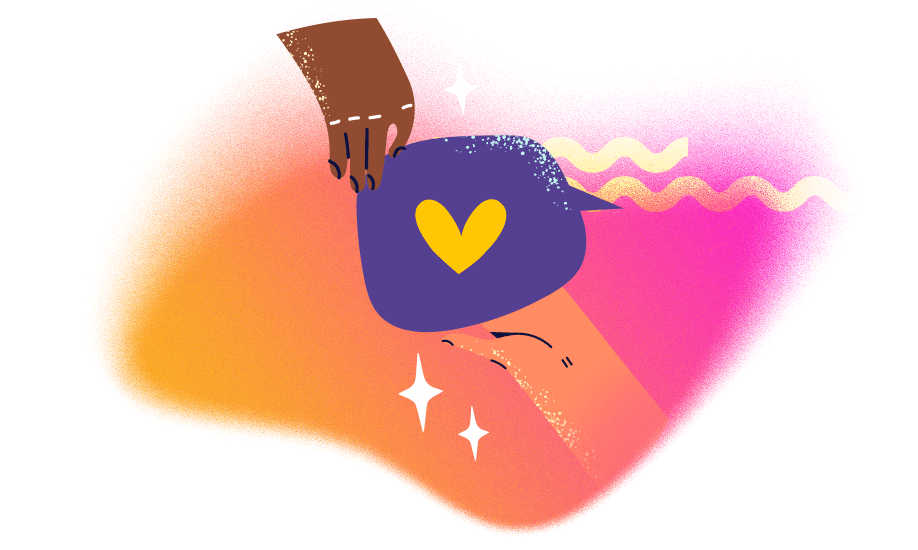
The subject of a recent Bigmouth team meeting shifted to an email from our owner, Jonathan Hart, about performance reviews. “That subject line should have come with a trigger warning,” said Dana Moran, our creative director of copy. She was only about 20% kidding.
The group laughed, and used the opportunity to share some of our most demeaning performance reviews. (Buy us a drink and we’ll dish.) We also recognized the moment for what it was — an opportunity born from our own vulnerability. That conversation would never have flown at our previous jobs, in part because we didn’t feel safe pushing back.
Choosing vulnerability is really, really tough, especially when past managers and colleagues put you through the wringer. Vulnerability is also a tool for bringing our whole selves to work at the creative workplaces we deserve.
In early 2020, Bigmouth embarked on a brand shift to come to terms with our identity as a business. A purpose-driven business came into focus, one where our voice is used as a force for good and where we celebrate how we live by changing how we work.
Vulnerability is a tool for bringing our whole selves to work at the creative workplaces we deserve.
Bigmouth’s work is focused on branding first and foremost. Creatives need emotional and professional confidence to move outside our internal lives and imagine a brand’s identity and personality. We need to start from a safe space to take this journey and build self-aware, authentic brands.
At Bigmouth, that space includes a culture of trust, celebrating close collaboration and diversity of thought, and enabling our teams to be adventurous through work/life balance.


Bringing our whole selves to work: What it is, and what it isn’t

We came across a few misguided hot takes about the concept of “bringing your whole self to work” while researching vulnerability and workplace trauma for this column. “Rarely has a phrase of corporate jargon raised so much ire and rolled as many eyeballs with everyone I’ve talked to about the subject,” moaned one columnist, citing a “friend and former manager of boomer vintage” who “credited her own success to religiously bringing her best self to work.”
OK, boomer. We credit our successes, our own best work, to feeling fulfilled and happy at work. And feelings of fulfillment and happiness come from being our whole, authentic selves.
Such “shut up and get back to work” screeds hit a particularly cruel note in 2023, when many folks are still working to acknowledge and process the myriad traumas of the COVID-19 pandemic. They also miss the point. Bringing your whole self to work doesn’t mean regressing into your collegiate behavior or oversharing about your toenail fungus. It means experiencing work as a real person with real emotions and opinions instead of flipping to Workbot mode from 9 to 5. It means being vulnerable.

Your whole self is also your favorite self
Peloton instructor Selena Samuela encourages students not to be their “best” selves, but to be their “favorite” selves.
“The word ‘best’ comes with a lot of preconceived ideas,” she said in a recent class. “It can be unnecessary pressure; it’s just convoluted and confusing sometimes. But ‘favorite.’ Favorite’s not confusing. You know what your favorite is.
So be your favorite you —
whatever that means today.”


How our past shared experience shape today’s Bigmouth workplace
Our conversation about reviews didn’t only help us share our worst critiques. It reminded us that we each bring a collection of work-related drivers and traumas to the Bigmouth table.
We pictured the Bigmouth team as a Venn diagram. Some of our sore spots are shared (timesheets, ugh), and others are unique. Criticisms of one person’s “professional comportment” led them to speak up less frequently; they felt their enthusiasm was unwelcome. Another worries about unearned success and struggles with a never-good-enough mentality, thanks in part to the grinding environment at past agencies.
Unpacking our shared and unshared experiences from toxic work environments requires a high level of psychological safety. Bigmouth is a small, tightly focused workplace, making it easier for us to agree on our “group norms” and foster safety. We realize that larger teams don’t often have this luxury.
We’re also committed to approaching Bigmouth as a trauma-informed workplace. One person’s annoyance about timesheets can trigger another person’s trauma, and those moments may be more pronounced in a small environment. We’re walking a fine line together, but we think we can succeed by being open and honest.

How leaders can model vulnerability:
- Who are a couple people who know your values and support your efforts to live into them?
- What does support from these people look like?
- What does honest feedback look like when you are living outside of your values?


The practice of leading with vulnerability

Folks in a leadership role have another important reason for bringing their whole selves to work: Who we are is how we lead. After giving a speech about leadership, Jonathan was approached by an audience member who identified Jonathan’s approach as “empathetic.” Later, he looked up Tony Robbins’ 11 styles and thought, “shouldn’t every leader be empathetic? How can you lead people if you don’t understand people?”
In the same vein, leaders can’t expect vulnerability if they don’t create a safe space for its existence. Here are a few tactics we’re trying:
Encouraging failure as an iterative process toward success. Show us a creative whose first idea or attempt was 100% on the nose and we’ll show you …well, we’ll tell you when we see them. Failure leads to empowerment and success—and it makes the creative process a lot more fun.
Developing client relationships where “no” is an acceptable answer. Clients are people too, and they bring their own professional traumas to the table. Let their experience with your agency be a model for what’s possible by building realistic expectations and bringing vulnerability to the relationship.
Producing what we promise—not more. Recently, we recognized that learned behaviors from past agencies were leading us to over deliver on every project. Those behaviors don’t serve our people-over-profits approach, so we’re working to un-learn them.
Mostly, we’re flying by the seat of our pants, taking note of the tactics that work and tossing those that don’t. But we’re being honest about it!
Now, we’re in the midst of that dreaded “review” period. After 1:1 chats with Jonathan, each team member submitted two questions seeking individual feedback from the group. We don’t want our process to feel punitive, but we all want to grow and be challenged. So at Bigmouth, we’ve defined reviews as a moment to assess what we’ve achieved together—both with our clients, and among ourselves.
Other recommended reading
Trauma At The Workplace, What To Do About It.
This 2021 column includes steps for creating a trauma-resilient workplace.
Trauma and Mental Health in the Workplace.
Insights from the One Mind at Work’s 2021 conversations with HR and benefits leaders



Bigmouth is on a mission to do good — and authentic relationships do good for our agency and our clients. We all carry traumas from bad working relationships (and class projects) with us. By choosing to be vulnerable and trust the potential of positive collaboration, we’re creating a world we want to work in.
We can’t do it all ourselves — join us! Bigmouth turns five in 2023. As part of our celebration, we’re publishing a five-part blog series on leadership in today’s creative world.
Sign up for our newsletter to stay in the loop and become part of our creative community.